Hesperian Health Guides
Common Problems Caused by HIV and How to Treat Them
HealthWiki > Where There Is No Dentist > Chapter 12: HIV and Care of the Teeth and Gums > Common Problems Caused by HIV and How to Treat Them
Contents
- 1 The main problems in the mouth for persons with HIV are:
- 2 1. White or yellow patches in the mouth (thrush, oral candidiasis)
- 3 2. Sores of the skin of the mouth (ulcers)
- 4 3. Infection of the gums (Vincent's infection, trench mouth)
- 5 More serious gum infection (gangrene of the face, Noma, Cancrum Oris)
- 6 4. Cold sores or fever blisters
- 7 5. Red or purple patches in the mouth (Kaposi's sarcoma)
- 8 6. Dry or painful mouth and throat
The main problems in the mouth for persons with HIV are:
- white or yellow patches
- open sores
- gum infections
- cold sores or blisters
- dark-colored skin patches
- dry or painful mouth and throat
1. White or yellow patches in the mouth (thrush, oral candidiasis)
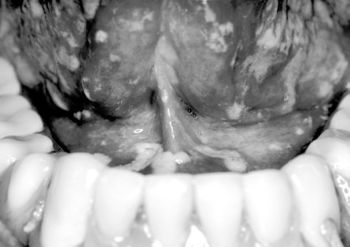
Thrush is the most common infection in the mouth seen in people with HIV infection. Thrush can also be a problem for people who do not have HIV.
Signs:
- A burning or swelling feeling in the mouth, especially when eating spicy foods. Because of pain, eating and swallowing become more and more difficult.
- The skin inside the mouth is usually covered with white, yellow, or red patches. If you try to remove the white patches with a clean cloth, they will come off, but sometimes leave a bleeding red surface underneath. In some people they may not come off easily. In a few people, there are no white patches. Instead, the skin of the mouth is red and blotchy. It may look very rough.

- Sometimes there are painful cracks
at the corners of the mouth that will
not heal and sometimes bleed.
Treatment:
Gently scrub the tongue and gums with a clean cloth or soft toothbrush 3 or 4 times a day. Then rinse the mouth with salt water and spit it out (do not swallow). In addition, if possible, use any ONE of these remedies:

- Put 1 ml (⅕ teaspoons) of nystatin solution in the mouth and hold it there 2 minutes and then swallow it. Do this 4 times a day for 14 days. OR,
- Use either chlorhexidine gluconate mouthwash. OR,
- Cut or break a 100 mg clotrimazole vaginal insert into 2 pieces of the same size. Each day, put 1 piece in the mouth and let it slowly melt there. The package may say: “Do not take by mouth.” This means do not swallow it. It is safe to let it melt in the mouth (this takes about 30 minutes), making sure it covers the whole inside of the mouth, and then spit it out. Do this once a day for 7 days (14 days if the infection is very bad). OR,
- Depending on how bad your problem is, suck one or two 100,000 Unit nystatin lozenges, 4 or 5 times a day for 10 to 14 days.
If thrush is very bad, or if it moves into your throat and makes it hard to swallow, you may try one of these stronger medicines instead of the remedies above. (But do not take either of these medicines if you are pregnant or breastfeeding):
- Take 200 mg of fluconazole by mouth once each day for 7 to 14 days. If you do not feel better in 3 to 5 days, increase the dose to 400 mg once each day. OR,
- Take one 200 mg tablet of ketoconazole, by mouth, once a day with food for 14 days.
2. Sores of the skin of the mouth (ulcers)
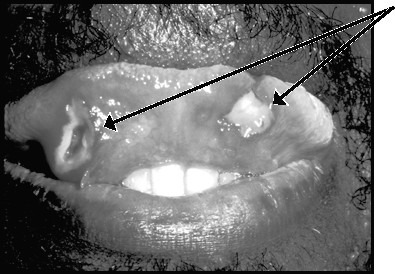
|
Open sores (ulcers) that can appear anywhere in the mouth. Usually the skin around the sores is red. The sores in this picture are on the inside of the top lip. |
Most people from time to time have had a small open sore (ulcer) in the mouth caused by an infection that has destroyed the skin in that area. It is usually painful and can make eating and speaking difficult for 1 or 2 weeks. The ulcer heals if the mouth is kept clean. For people with HIV infection, the healing process can be very slow and sometimes the sore area in the mouth becomes very large. This is especially true if the person is taking antiretroviral therapy (ART) to treat HIV.
Signs:
The skin lining the mouth or on the tongue is broken and will probably look much redder than the skin that is not broken.
Treatment:
Keep the area clean to control the infection and to help the skin heal. Clean the sores with a cotton swab dipped in 1% povidone iodine. Also, see other methods for keeping the mouth clean.
Also give antibiotics if:
- the skin around the ulcer is very swollen, AND
- you feel soft lumps (lymph glands) underneath the lower jaw bone.
Give 500 mg of amoxicillin by mouth, 3 times a day for 7 days. (Not safe for people allergic to penicillin. Anyone who is allergic to penicillin will also be allergic to amoxicillin and ampicillin).
OR 100 mg of doxycycline by mouth, 2 times a day for 7 days. (Not safe for people who are pregnant or breastfeeding).
OR 500 mg of tetracycline by mouth, 4 times a day for 7 days. (Not safe for people who are pregnant or breastfeeding).
OR 500 mg of erythromycin, 4 times a day for 7 days.
3. Infection of the gums (Vincent's infection, trench mouth)
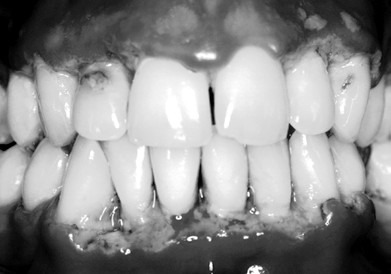
Many people have some infection of the gums around their teeth (called “gingivitis”). If the mouth and gums are not kept clean, or if the person’s body is not able to fight off disease, the infection may get so bad that the tissue of the gums will begin to die (called “Vincent’s infection” or “trench mouth”).
This severe infection of the gums is more likely in people who have HIV, who smoke, who are malnourished, or who experience mental stress. If not treated, it can spread to the jaw bone and nearby tissue and cause the teeth to loosen and fall out.
Signs that are always present:
- Red, puffy gums that bleed easily.
- Severe pain in the gums that begins suddenly.
- Sores (ulcers) and dead tissue on the gums between teeth.
Signs that may be present:
- Very bad breath.
- Fever.
- A sore or stiff neck, with soft lumps just underneath the lower jaw bone.

Treatment:
- Very gently remove the tartar around the teeth. Be especially careful not to cause damage to the gums.
- Keep the area clean to control the infection and to help the skin heal. The best mouthwash for this is chlorhexidine gluconate 0.12% used 2 times a day for 14 days.
- Give antibiotics.
| ANTIBIOTIC TREATMENT OF VINCENT’S INFECTION | |||
|---|---|---|---|
| Name of medicine | Age | Dose | How to take |
| Metronidazole | 1 to 2 years | 50 mg, 3 times a day | By mouth for 5 to 7 days |
| 3 to 6 years | 100 mg, 2 times a day | ||
| 7 to 9 years | 100 mg, 3 times a day | Do not give to people during the first 3 months of pregnancy | |
| 10 to 17 years | 250 mg, 3 times a day | ||
| 18 years and older | 500 mg, 3 times a day | ||
| OR | |||
| Amoxicillin + clavulanic acid (500 mg amoxicillin/ 125 mg clavulanic acid) | 17 years or younger | 20-40 mg amoxicillin/kg/day, divided in 3 doses | By mouth for 5 to 7 days. |
| 18 years and older | 500 mg amoxicillin + 125 mg clavulanic acid, 3 times a day | Do not give to people who are allergic to penicillin. | |
| OR | |||
| Clindamycin | 1 to 5 years | 150 mg, 3 times a day | By mouth for 5 to 7 days. |
| 6 to 8 years | 300 mg, 3 times a day | ||
| 9 years and older | 450 mg, 3 times a day | ||
Once the area is clean and the infection is controlled, take out any teeth that are very loose.
More serious gum infection (gangrene of the face, Noma, Cancrum Oris)
Signs:

In the most severe gum infection, the jaw bone will become infected and this can spread through the cheek to the face. This will be very easy to see, as parts of
the face and jaw rot away and smell bad. It happens mainly to very sick and malnourished children (usually one to four years old), but can also happen to adults with HIV infection.
Treatment:
Get medical help as quickly as you can — in a hospital if possible.
In the meantime, see the information on cleaning and treating the gangrene.
See information about medicines (antibiotics) for children. For an adult, give the following:
For an adult who is able to swallow:
- give 500 mg of metronidazole by mouth, 3 times a day for 10 days,
- AND give 500 mg of amoxicillin by mouth, 3 times a day for 7 days.
For an adult who cannot swallow:
- inject 900 mg of clindamycin into a large muscle, 3 times a day, for 5 days.
If you give the medicine by injection, change to medicines by mouth once the person can swallow. But do not stop giving the medicines until the 7 to 10 days have passed. It is just as important that the person eats plenty of nutritious food.
Note: Clindamycin and amoxicillin are safe to use for people who are pregnant or breastfeeding. Metronidazole should be avoided in the first 3 months of pregnancy and while breastfeeding. If a person is breastfeeding and taking clindamycin and it gives the baby diarrhea, the medicine should be stopped.
4. Cold sores or fever blisters
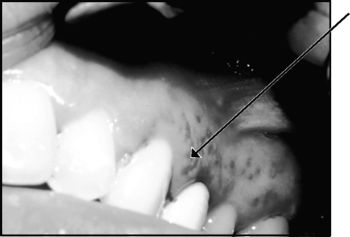
Many people get cold sores or fever blisters caused by the herpes virus. People who become infected with herpes carry the virus forever. Most people are infected as children.
The herpes sores can come and go. The herpes sores usually heal after 1 or 2 weeks. But for persons infected with HIV, the sores come more often and last much longer.
Signs:
- One or more small, sometimes painful, red blisters appear on the lips and skin around the mouth. In people with HIV infection, they also appear just inside the lips, and on the gums and the roof of the mouth.
- The blisters burst and become small open sores that often spread into each other.
- After the blisters on the lips burst, a yellow crust forms over them.

The herpes sores can pick up other infections, particularly in people with HIV infection. Also, the liquid inside the sores and blisters can spread infection. If herpes is spread to the eyes, it can cause blindness. Keep fingers and hands away from sores because they contain very active virus. It is very important to wash the hands before and after touching the face or eyes.
Treatment:
Medicine cannot kill the herpes virus. Keep the area clean to control any infection in the sores and to help them heal. Keep fingers and hands away from the sores, and drink lots of fluids. See information about other methods of keeping the mouth clean.
Also:

- Begin treatment as soon as you feel a tingling, before the cold sore appears. This may stop the sore from developing or developing so severely.
- Clean sores with soap and water 2 times a day until they have healed. Keep the sores clean and dry. Wash hands carefully before and after cleaning sores.
- A medicine called acyclovir may also help. Give 400 mg by mouth, 3 times a day for 7 to 10 days. You can also apply a small amount of acyclovir ointment on the sores 5 times a day for 4 days. It is OK to use them both at the same time. Acycolvir works best if taken or used early in the infection, before the blisters burst, if possible.
- If the sores are infected, give 500 mg of amoxicillin, 3 times a day for 7 days.
OR for persons allergic to amoxicillin, give 100 mg of doxycycline, 2 times a day for 7 days.
OR for a person who is allergic to penicillin, and is pregnant or breastfeeding, give 500 mg of erythromycin, 4 times a day for 7 days.
- Antibacterial ointments such as mupirocin can also help to prevent and control other infections that get into the sores. Stop using the acyclovir and spread a small amount of anti-bacterial ointment on the infected skin outside the mouth (not in the mouth) 3 times a day for 7 days.
5. Red or purple patches in the mouth (Kaposi's sarcoma)
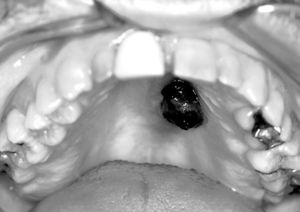
Some people infected with HIV will get red- or purple-colored patches in the mouth. These patches are called Kaposi’s sarcoma and they can also appear elsewhere on the body. Kaposi’s sarcoma can be an early sign of HIV infection.
Signs:
Painless patches that look like swollen bruises around or inside the mouth. The red or purple color is more obvious in the mouth. The patches rarely become infected and painful, usually only if they burst.

Treatment:
Get advice from a health worker or doctor who has experience working with people with HIV. People who are taking antiretroviral therapy (ART) are less likely to get Kaposi's sarcoma. And starting ART is an important part of treating it. Other treatments include medicines and radiation used to treat other types of cancer, applied directly to the tumor or to the whole body.
6. Dry or painful mouth and throat
Many people with AIDS have difficulty eating near the end of their lives because of a dry or painful mouth and throat. But it is important to eat nutritious food during a sickness, even a serious sickness like AIDS. The person will feel much more comfortable and have less pain and infection if they can eat well.

A dry mouth can be caused by an infected swelling in the glands of the mouth that usually make spit (saliva). This is most common for people taking antiretroviral therapy (ART). A painful mouth can be caused by other infections and problems that come with HIV and AIDS. See information about how to treat an infection of the spit gland. For help with eating if the mouth is very dry or sore, try the following:

- Eat soft foods in small pieces that are easy to chew and swallow.
- Cook foods until they are soft and tender.
- Mix foods with liquids to make them easier to swallow.
- Keep a small bottle of drinking water with you all the time.
- Use a straw to drink fluids.
- Do not eat hot or spicy foods. They can irritate a sore mouth and throat.
- If it is difficult to swallow, tilt the head back a little, or move it forward.
- Rinse the mouth with clean water often. This will remove food and germs, and help with healing.












